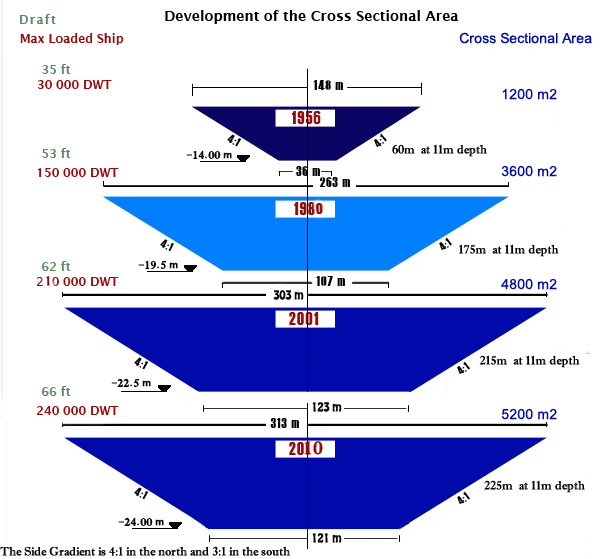The dredging of the canal took almost 10 years using Egyptian labor, and it was opened for navigation for the first time in 17 November 1869. Its depth was about 8 meters, its water are was 304 m 2 and the largest ship load that can pass through was 5000 tons, which was typical for ships sizes in these days. As the ships developed and increased its sizes, the canal needed to be developed, which happened when it was still a foreign joint venture before being publicized to take ships with depth of 35 feet and its water area to be 1200 m 2 by the end of 1956 and when the canal was publicized by the Egyptian government on the 26th of July 1956. The Egyptian administration was keen to develop the Navigation canal even more on different stages.
In May 1962, the water area of the canal was to reach 1800 m 2 and the allowed depth to 38 feet. In June 1966, a development was to be executed on 2 stages as it was announced the depth would reach 48 and 58 feet consecutively. This program was started, but was soon halted due to the war that erupted on the 5th of June, 1967. It was reopened for international; navigation in June 1975 after purifying it from the ships that sank in its bottom during in the 1967 and 1973 wars,The canal still with the same water area and depth as before it was closed.
The development projects then started by the Egyptian administration and received to ships of a 210,000 tons load, specially after increasing the water area to 4800 m 2 and a ship draft of 62 feet , with a length of 191.80 km, in addition to the redesign of the canal's turns so that each one has a radius of at least 5000 m and also dredging a new bypass starting from the 17th km south of port said heading directly to the Mediterranean east of port Fouad to allow the loaded ships going north to go to the sea without passing through port said port.
The ship draft reached 66 feet by 2010,this stage taking all container vessels; about 17,000 container vessels; as well as taking all bulk vessels world wide. The Canal will be able to take in about 99 % of all methods used in world maritime transport after reaching a depth of 72 feet (Target stage,Under Study), as well as taking about 96.2% of the dead weight tons for the bulk vessels 80.3% of the petroleum tanks and a 100% of all the remaining types of ships used in maritime transport; specially container vessels with all its future generations; in addition to empty vessels reaching up to 440 thousand tons.
Stages of developing the Suez Canal :
Item
|
Unit |
1869 |
1956 |
1962 |
1980 |
1994 |
1996 |
2001 |
2010 |
2015 |
Overall Length
|
Km
|
164 |
175 |
175 |
189.80
|
189.80
|
189.80
|
191.80
|
193.30 |
193.30
|
| ByPasses Length |
Km |
-- |
27.7 |
27.7 |
77 |
77 |
77 |
79 |
80.5
|
113.3
|
| Width at 11 m depth |
m |
-- |
60 |
89 |
160/175 |
170/190 |
180/200
|
195/215
|
205/225
|
205/225
|
Water depth Max.
|
m |
8 |
14 |
15.5 |
19.5 |
20.5
|
21 |
22.5 |
24 |
24 |
Draft of ship
|
Feet
|
22 |
35 |
38 |
53 |
56 |
58 |
62 |
66 |
66 |
Cross Sectional Area
|
m 2 |
304 |
1200
|
1800 |
3250/3600
|
3600/4000 |
3850/4300
|
4350/4800
|
4800/5200
|
4800/5200
|
Max. Loaded ship
|
DWT |
5000 |
30000 |
60000 |
150000 |
170000
|
185000 |
210000 |
240000
|
240000
|
Note : Bypasses length is calculated according to the kilometric numbering of buoys at the beginning and end of each bypass.
Cross Sectional Area:

Capacity of the Canal:
Suez Canal Authority has completed its planned phase to increase the Canal permissible draft to 66 ft at January 2010.
This enables the Canal to accommodate the following percentages of the fully loaded vessels:
61.2 % Of the Tanker Fleet
92.7 % Of the Bulk Carrier Fleet
100 % Of the Container Ships & Other Ships